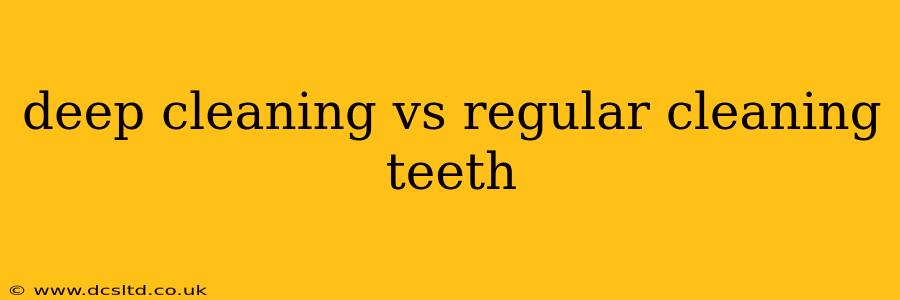Maintaining optimal oral hygiene is crucial for overall health. While regular brushing and flossing form the foundation of a healthy mouth, understanding the difference between regular cleaning and deep cleaning is key to preventing serious dental problems. This comprehensive guide will clarify the distinctions, benefits, and necessity of both.
What is Regular Teeth Cleaning?
Regular teeth cleaning, also known as professional cleaning or prophylaxis, is a preventative procedure typically recommended every six months. During this appointment, your dentist or hygienist will:
- Remove Plaque and Tartar: Professional tools effectively remove plaque and tartar buildup that brushing and flossing may miss. Plaque, a sticky film of bacteria, can harden into tartar if not removed, leading to gum disease and cavities.
- Polish Teeth: Polishing smooths the tooth surfaces, making it harder for plaque to adhere. This leaves your teeth feeling smoother and looking brighter.
- Examine Your Mouth: A thorough examination checks for cavities, gum disease, and other oral health issues. This early detection allows for prompt treatment, preventing more significant problems down the line.
- Provide Oral Hygiene Instructions: Your dental professional will reinforce proper brushing and flossing techniques, ensuring you're effectively caring for your teeth at home.
What is Deep Cleaning (Scaling and Root Planing)?
Deep cleaning, also known as scaling and root planing, is a more intensive procedure necessary for individuals with gum disease (periodontitis). It addresses the deeper layers of infection beneath the gum line that regular cleanings can't reach. The process involves:
- Scaling: This removes plaque and tartar from below the gum line, where it contributes significantly to gum disease. Special instruments are used to carefully clean the root surfaces of each tooth.
- Root Planing: This smooths the tooth roots to make it more difficult for bacteria to reattach and cause further infection.
- Post-Treatment Care: Your dentist will provide detailed instructions on post-treatment care, including using an antiseptic mouthwash and maintaining meticulous oral hygiene.
How Often Should I Get a Regular Cleaning?
The American Dental Association (ADA) generally recommends professional cleanings every six months. However, individuals with a higher risk of gum disease or other oral health issues may need more frequent cleanings. Your dentist will determine the optimal cleaning schedule based on your individual needs and oral health status.
What are the signs that I need a deep cleaning?
This is a frequently asked question, and the answer involves identifying symptoms of gum disease. Signs you may need a deep cleaning include:
- Bleeding Gums: Persistent bleeding while brushing or flossing is a key indicator of gum inflammation.
- Red, Swollen, or Tender Gums: These are signs of gingivitis, the early stage of gum disease.
- Receding Gums: Gums pulling away from the teeth exposes more of the tooth root, making it vulnerable to infection.
- Persistent Bad Breath: Bad breath that doesn't improve with brushing and flossing may indicate an underlying infection.
- Loose Teeth: If your teeth feel loose or are shifting, it's a serious sign requiring immediate attention.
What's the Difference in Cost Between Regular and Deep Cleaning?
The cost of a regular cleaning is typically lower than a deep cleaning. Deep cleanings require more time and specialized procedures, resulting in a higher price. The exact cost will vary based on location, dental practice, and the extent of the procedure needed.
Does insurance cover deep cleaning?
Most dental insurance plans cover at least a portion of the cost of deep cleaning, particularly if it's deemed medically necessary due to gum disease. However, the coverage amount can vary depending on your specific plan. It's crucial to check with your insurance provider to understand your coverage.
Is Deep Cleaning Painful?
While some discomfort is possible during a deep cleaning, most patients tolerate the procedure well. Your dentist will use local anesthetic to numb the area, minimizing any pain. After the procedure, some tenderness and slight bleeding may occur, but this typically subsides within a few days.
Can I Prevent the Need for Deep Cleaning?
The best way to avoid the need for deep cleaning is to maintain excellent oral hygiene at home and visit your dentist for regular checkups. This involves:
- Brushing Twice Daily: Use a fluoride toothpaste and soft-bristled toothbrush.
- Flossing Daily: Floss to remove plaque and food particles from between your teeth.
- Using Mouthwash: An antimicrobial mouthwash can help kill bacteria and reduce plaque buildup.
- Maintaining a Healthy Diet: Limit sugary drinks and snacks to minimize bacterial growth.
- Regular Dental Checkups: Attend your six-monthly checkups for professional cleaning and early detection of problems.
By understanding the differences between regular and deep cleanings and prioritizing proactive oral hygiene, you can significantly improve your oral health and prevent the need for more extensive and costly procedures in the future. Remember, consistent care is the key to a healthy and beautiful smile.
